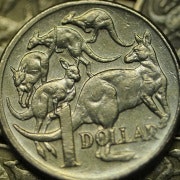Will the RBA get its way on the Aussie in 2014?
The Reserve Bank of Australia has ramped up the currency rhetoric in recent weeks, aggressively talking the Aussie dollar down. Earlier in 2013 the bank was dancing around the issue and preferred to refer to the fact that our terms of trade had peaked; this then moved to comments about an “uncomfortably high” Aussie dollar and talk of intervention. On Dec 13 – for the first time – there was a mention of a US85 cent level from Governor Glenn Stevens.
The central bank's timing could be perfect and the market may just help to deliver the RBA what it wants in 2014.
Australia on shaky ground
Once the darling of the international currency markets, the Aussie dollar's allure is beginning to fade. Gone is the talk of perpetual expansion in economic growth, driven by a return to double-digit growth out of China. Instead we have a flat-lining 2.3 per cent annual GDP rate and the RBA governor warning against “building up this myth of 22 years of uninterrupted growth” and that “sooner or later we’ll have another downturn”.
AAA government bonds are not as attractive as they once were due to a higher budget deficit, and in particular, increased government debt levels that serve to threaten the ratings of these bonds at some point. Add to this record low interest rates and the possibility of more cuts to come in 2014 and it’s no major surprise that there has already been some increase in capital outflows from what was once a crowded bond market.
2014 could be the year ratings agencies downgrade Australian government paper. Such news would only serve to increase capital outflows, dragging the Aussie down as a consequence.
Whilst there are some signs the RBA’s low interest rate policy is gaining traction, particularly around the housing sector, it is clear the Australian economy is in decline and will face some stern challenges in 2014 as the re-balancing out of mining continues.
US Fed – hard or soft?
These are just the local issues. If we throw the gradual improvement in the US economy into the mix then we get an even more compelling argument for a lower Aussie dollar.
Following much conjecture the US Federal Reserve finally delivered on a promise first delivered back in May having announced they would reduce the pace of its monthly asset purchases to $75 billion by the beginning of January.
While markets seemed more prepared this time around, what softened much of the initial blow for growth currencies like the Australian dollar was the underlying dovish tone of Ben Bernanke who further anchored interest rate increases to the underlying unemployment rate which would need to fall further to 6.5 per cent from its current level of 7.0 per cent.
Keeping in mind the importance of a gradual improvement in the labour market until it will even be considered appropriate to raise rates, it’s predicted the FOMC will from this point adopt a steady reduction in monthly bond purchases each month to ensure their withdrawal from the stimulus game creates as few disruptions and shocks as possible.
Given monetary policy settings within US have been a focal point across currency markets for so long it appears the pace of the Fed’s withdrawal will greatly dictate the magnitude of the falls expected for the Australian dollar during 2014. With the tapering debate now set to be more focussed on when it will end it is expected the pledge to maintain interest at low levels until 2015 will becoming an increasingly important one for those investors wanting a stronger Greenback sooner rather than later.
85 cents by when?
I expect an increase in volatility during 2014 with more central bank action worldwide and a new phase in the global economic cycle driving funds into recovering economies. The direction of the RBA and Fed policies puts this into perspective as the two economies are at almost opposite ends of the economic cycle.
So if the Fed has completely withdrawn stimulus or looks like doing so by June 2014, and the RBA continues its easy monetary policy, then I expect the decline in the Aussie to 85 cents will happen by the second quarter of 2014.
The big risk to this view is whether or not the global economy can live without the extraordinary stimulus it has become accustomed to since the GFC, and if quantitative easing remains in place into the second half of 2014.
Jim Vrondas is chief currency and payment strategist, Asia-Pacific at OzForex, Australia's leading international money transfer service. OzForex's cutting edge technology powers foreign exchange services for 100,000 private and institutional clients across six continents, and the company is a key provider of Forex news.















